Spring Exhibition 2022
YEOVIL'S FASHIONS CAPTURED BY THE CAMERA
Spring Exhibition 2022 - presented by Yeovil's Virtual Museum
![]()
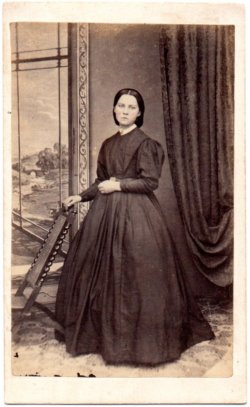 Photo by John Swatridge, c1860 |
|
![]()
About the Spring 2022 Exhibition
Today, of great value, is the recording of how ordinary Yeovilians looked and dressed through the decades. The vast legacy of cartes de visite and cabinet cards, followed by professionally-produced postcards and domestic photographs, have produced significant documentation of the fashions in clothing for both women and men.
This Spring 2022 Exhibition of Yeovil's Virtual Museum looks at the fashions of all classes of people in Yeovil from the 1850s to the 1920s. It should be borne in mind that a visit to the photographer’s studio, or even a home visit, would often have been a special occasion and called for the sitter to be attired in their ‘Sunday best’.
All photographs, except the 'glass chamber', are from my collection.
Introduction
Modern photography began in the late 1830s in France. Joseph Nicéphore Niépce used a portable camera obscura to expose to light a pewter plate coated with bitumen. This is the first recorded image that did not fade quickly.
The late 1840s saw the introduction of the photographic studio in England when the new 'science' of photography meant that a 'likeness' would soon become affordable for the masses. As with other towns, Yeovil saw its fair share of photographic artists setting up studios.
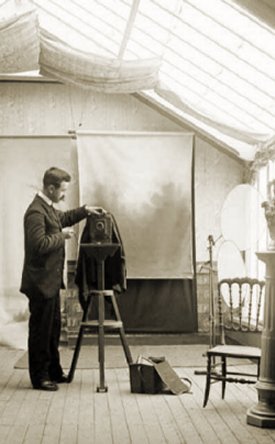 A typical photographer's 'glass chamber' |
|
In 1847, Thomas Sharp of London would become the first of several visiting professional photographers to set up temporary photographic studios in Yeovil, usually within existing shop premises. These temporary studios would exist for just a few weeks or several months - the ‘season’. Yeovil soon began to have more permanent studios created in the town. The first of Yeovil’s professional photographers was probably John Swatridge who, together with his son Thomas, set up a photographic studio in his shop premises in Princes Street during the 1850s. Since lighting for photography was a real problem at this time, the majority of the new studios, frequently called ‘glass chambers’, were little more than greenhouses equipped for photographic portraiture as seen at left. |
The next great
step forward in
photography was
the invention of
the carte de
visite, patented
in 1854 in
France by Andre
Adolphe Eugene
Disderi. The
carte de visite
image, or
images, were
usually taken in
multiples of
eight or less
and were small
enough for the
photographer to
take eight
images on a
whole plate
camera fitted
with four lenses
and a repeating
back. Most would
produce the same
image multiple
times but,
depending on the
camera and the
lens set-up,
some could
accommodate
various poses on
one photographic
plate.
Cartes de visite (also known as cartes or CDVs) are small paper-on-card photographs. The size of cartes quickly became standardised and they typically measure 4" x 2½" (102mm x 62mm). The photograph which was pasted on to the card was roughly cut to about 3½" x 2¼" (90mm x 57mm). They were never actually used as visiting cards.
Cartes de visite were introduced in Britain in 1859 and became a relatively cheap way for almost anyone to have their photograph taken. The newly-invented negative/positive process allowed photographers to easily produce multiple copies. This had not been possible with earlier photographic processes such as the ambrotype and the daguerreotype. By keeping the negatives, the photographer could offer reprints at any time after the initial sitting - a fact usually advertised on the back of the carte.
The ability to reproduce images in bulk, led to a fashion for Victorians to collect photographs of famous people, topographical views and a whole range of other subjects. This fashion was boosted in 1860 when the society photographer, JE Mayall, produced a set of photographs of the Royal family. As cartes became cheaper, people began to swap images with their friends and around 1870 leather-bound albums with bright brass clasps became popular. Until then, cartes had square corners, but these tended to rip the openings in albums. So, from around this time, cartes began to have rounded corners - an easy way to roughly date a carte.
Throughout the 1860s and 1870s the passion for collecting cartes boomed and literally millions were produced across the country each year. It has been called the start of ‘cartomania’.
Cabinet cards - a larger version of the carte - were introduced in 1866 by the London company of Window & Bridge to revitalise the flagging sales of cartes. However, they did not become really popular until the late 1880s and 1890s. Cabinet cards were the larger version of the carte de visite and customers were often sold the same photograph in both sizes. The photograph of a cabinet card measures 5½” x 4” (140mm x 100mm) and is pasted onto a mount measuring 6½” x 4¼” (165mm x 115mm). Cabinet cards usually have the studio name and address printed at the bottom.
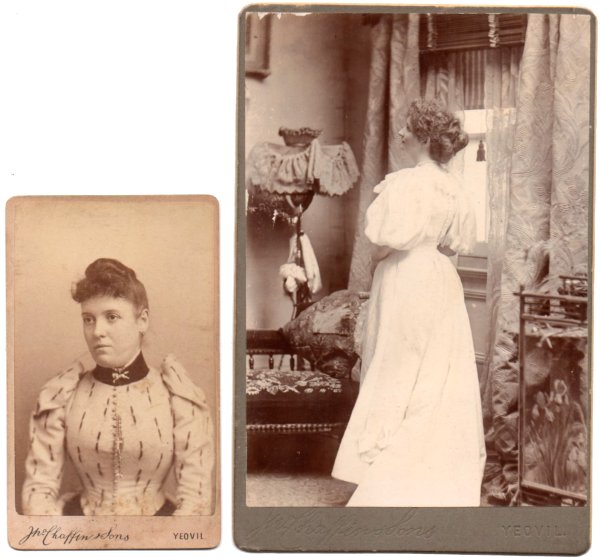
For size
comparison, at
left is a carte
de visite by
John Chaffin &
Sons of Hendford
(next door to
the Butchers
Arms), at right
is a cabinet
card also by
John Chaffin &
Sons, but
appears to be a
portrait taken
in the sitter’s
home. Both date
to the 1890s.
Cartes measure
approximately 4"
x 2½" (102mm x
62mm), while
cabinet cards
measure 6½” x
4¼” (165mm x
115mm).
The carte de visite format continued in use until around the turn of the twentieth-century, while the cabinet card persisted until about 1910. By this time, both had been replaced by the much cheaper postcard format.
As an example of the cost of a photograph - the visit to the studio was generally free and the following list of prices, from John Bell of Hendford in 1896, are typical -
-
Cartes de visite - 12 copies from 7 shillings (about £35 at today's value)
-
Cartes de visite - 6 copies from 4 shillings
-
Cartes de visite - 3 copies from 2s 6d
-
Re-orders - 6d each, any number
-
Cabinet Cards - 12 copies from 12 shillings
-
Cabinet Cards - 6 copies from 7s 6d
-
Cabinet Cards - 3 copies from 4s 6d
-
Re-orders - 1s each, any number
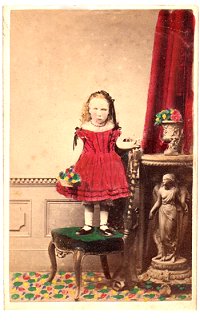 Many of the
early
photographers
had originally
trained as
artists and a
frequently-offered
service was to
provide a
coloured version
of the
photograph.
This was often
achieved by
creating a
portrait in
oils, or other
medium, as a
direct copy of a
photograph.
Alternatively,
as in this
example at left
(not a Yeovil
photographer), by
painting
directly onto
the photograph.
Many of the
early
photographers
had originally
trained as
artists and a
frequently-offered
service was to
provide a
coloured version
of the
photograph.
This was often
achieved by
creating a
portrait in
oils, or other
medium, as a
direct copy of a
photograph.
Alternatively,
as in this
example at left
(not a Yeovil
photographer), by
painting
directly onto
the photograph.
For example, John Chaffin of Hendford, employed his three daughters as artists to create lifelike portraits in oil paints or to colour monochrome prints. Louisa at the Hendford studio and at Taunton by her elder sisters Kate and Maria, who had earlier been listed as artists.
Fashions of the 1850s
Around 1856, skirts expanded creating a dome shape,
due to the
invention of the
artificial cage crinoline. The purpose of the crinoline was to create a
simulated
hourglass
silhouette by
accentuating the
hips and,
together with
the corset,
creating the
illusion of a
small waist. The
cage crinoline
was made from
thin strips of
metal, forming a
circular
structure to
support the
large width of
the skirt. The
introduction of
the crinoline
freed women from
the great weight
of many layers
of petticoats
and was a much
more hygienic
option.
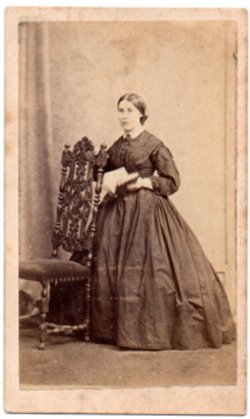 Proving
that
almost
anyone
could
afford a
carte de
visite,
this
carte de
visite
is of
Susan
Ellis
(1839-1903)
originally
from
Halstock,
Dorset,
who, in
the 1861
census
(three
years
after
the time
of this
photograph)
was
listed
as a
23-year
old
servant
living
with and
working
for the
family
of
bookseller,
stationer
and
printer
Henry Wippell
at
(today's)
1 & 3
Princes
Street.
Proving
that
almost
anyone
could
afford a
carte de
visite,
this
carte de
visite
is of
Susan
Ellis
(1839-1903)
originally
from
Halstock,
Dorset,
who, in
the 1861
census
(three
years
after
the time
of this
photograph)
was
listed
as a
23-year
old
servant
living
with and
working
for the
family
of
bookseller,
stationer
and
printer
Henry Wippell
at
(today's)
1 & 3
Princes
Street.
Susan's
dress is
typical
of the
mid- to
late-1850s
before
the full
crinoline
became
fashionable.
She holds a book - symbolising an educated young lady (as well as the fact that she worked for a bookseller). The background has a simple swag of material to one side and Coggan's ornate studio chair appears in many of his photographic portraits.
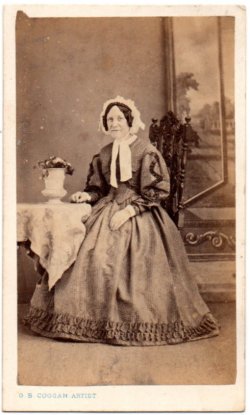 This older lady wears a dark silk morning crinoline dress
with the skirt
almost conical
and dressed
simply with
ruching around
the hem. The
sleeves are wide
and heavily
decorated.
This older lady wears a dark silk morning crinoline dress
with the skirt
almost conical
and dressed
simply with
ruching around
the hem. The
sleeves are wide
and heavily
decorated.
This lady's hair is dressed simply,
middle parted
and in a bun or
wound braid at
the back, with
the sides puffed
out over the
ears. She wears
an indoor cap
with long
ribbons which,
by this time,
was a little
dated and would
usually only
have been worn
by the older
generation.
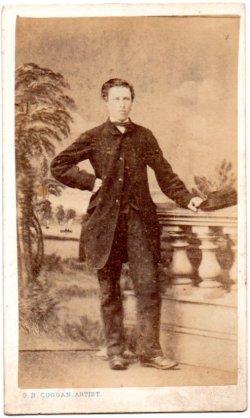 This
gentleman wears
a long frock
coat, for informal day wear, over a
straight cut,
single-breasted
waistcoat and
trousers of a
similar
material.
This
gentleman wears
a long frock
coat, for informal day wear, over a
straight cut,
single-breasted
waistcoat and
trousers of a
similar
material.
This photograph features a painted backdrop and the man rests on a moveable prop balustrade for stability during the photograph's exposure.
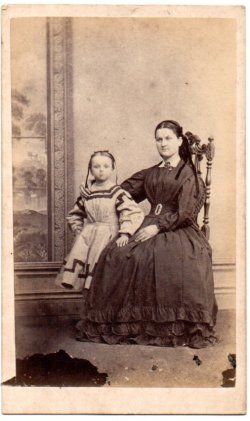 This lady has a similar dress to the previous photograph of the
older seated
lady. It has a high collar in contrasting white,
very full sleeves, a belt with a
large buckle at
the waist and
three layers of
frills at the
hem.
This lady has a similar dress to the previous photograph of the
older seated
lady. It has a high collar in contrasting white,
very full sleeves, a belt with a
large buckle at
the waist and
three layers of
frills at the
hem.
Her daughter wears a dress with a
design based on
adult’s
clothing. Like
her mother, she
has long dark
ribbons in her
hair.
Fashions of the 1860s
After about
1862, the
silhouette of
the crinoline
changed and
rather than
being
bell-shaped it
was now flatter
at the front and
projected out
more behind. In
men's fashion,
the sack coat
and cutaway
morning coat,
waistcoat, and
trousers in the
contrasting
fabric continued
as the norm.
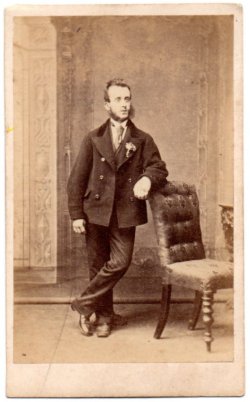 This
is the
earliest carte
by John Chaffin,
from 1862,
before Chaffin
started to have
the backs of his
CDVs printed (it
has a
hand-written
back).
This
is the
earliest carte
by John Chaffin,
from 1862,
before Chaffin
started to have
the backs of his
CDVs printed (it
has a
hand-written
back).
The sitter’s
early style sack
coat is typical
of this period.
The sack suit,
or lounge suit
as it was termed
in Great
Britain,
originated in
France as the sacque
coat during the
1840s and took
its name from
the way it was
cut (contrary to
popular belief,
the sack coat
did NOT get its
name from its
loose fit “like
a sack”).
The full length
portrait was
normal during
this period,
with clear areas
of floor visible
below the
sitter. The
background is
quite plain and
the props are
sparse. Note the
base of a neck
clamp behind the
sitter’s feet.
Neck clamps were
used in order to
stop the
sitter’s head
moving.
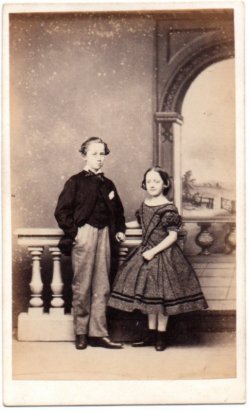 Again,
one of the very
earliest cartes
de visite by
John Chaffin,
almost certainly
dating to 1862.
In this
instance,
Chaffin had
bought a
standardised
carte with a
printed back
with name and
address
hand-written
indicating that
he had still yet
to organise the
printing of his
own carte
stocks.
Again,
one of the very
earliest cartes
de visite by
John Chaffin,
almost certainly
dating to 1862.
In this
instance,
Chaffin had
bought a
standardised
carte with a
printed back
with name and
address
hand-written
indicating that
he had still yet
to organise the
printing of his
own carte
stocks.
For most of the nineteenth century children's clothes were all but replicas of their parents fashions, the exception being that young girls' dresses were shorter than adults.
The same painted
backdrop as in
the next
photograph is
seen, featuring
a rural
landscape. The
balustrade prop,
for support
during the long
photographic
exposure, was
appropriately
short for the
use of children,
although as seen
at the left edge
clearly isn't
long enough to
be convincing.
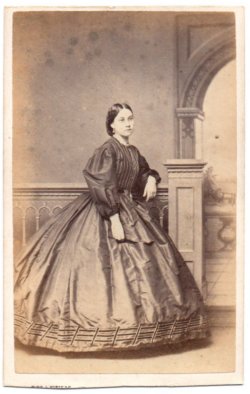 Another
very early carte
by John Chaffin
from around
1862, featuring
the lady’s
dress, with its
full,
bell-shaped
crinoline
skirts, typical
of this date.
The fashion
would change
dramatically
within a year or
two.
Another
very early carte
by John Chaffin
from around
1862, featuring
the lady’s
dress, with its
full,
bell-shaped
crinoline
skirts, typical
of this date.
The fashion
would change
dramatically
within a year or
two.
Her hair style, centre-parted and swept back showing her ears is another indicator of this period.
The same painted backdrop as in the previous photograph is seen again. It was typical of the period and shows a simplified opening with a view through to the outside.
The balustrade
studio prop, on
which the lady
rests was
moveable and
features in many
of Chaffin's
studio portraits
for many years.
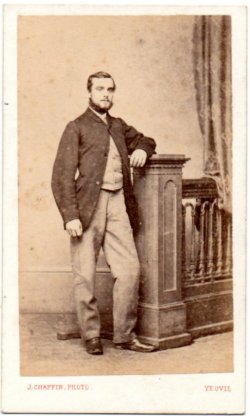 This
man, also
photographed by
Chaffin in 1863,
wears a
tailored,
mid-thigh length
morning coat
that tended to
be worn for more
formal day
occasions.
This
man, also
photographed by
Chaffin in 1863,
wears a
tailored,
mid-thigh length
morning coat
that tended to
be worn for more
formal day
occasions.
The morning coat was cutaway, as here, so that only the top button could be fastened. It was ideal for business wear. Waistcoats, usually in a contrasting, plain material, were generally cut straight across the front and had lapels. He wears traditional contrasting light-coloured trousers.
The props are a
simple swag of
material and the
moveable
balustrade makes
another
appearance.
Note behind the
the man’s legs
are the feet of
a neck brace to
keep him from
moving his head
during the long
exposure time.
Fashions of the 1870s
1870's fashion
is characterised
by a gradual
return to a
narrow
silhouette after
the full-skirted
fashions of the
1850s and 1860s.
By 1870,
fullness in the
skirt had moved
to the rear,
where
elaborately-draped
overskirts were
supported by a
bustle and
secured by
tapes. This
necessitated an
underskirt,
which was
heavily trimmed
with pleats,
ruching, and
frills. The
bustle was
short-lived at
this time,
although it
would return
again in the
mid-1880s. It
was followed by
a tight-fitting
silhouette. The
cuirass bodice,
a long-waisted,
boned bodice
extending into a
point below the
waistline in
both front and
back. Sleeves
were very tight
fitting. Square
necklines were
common and day
dresses had high
necklines that
were either
closed, squared,
or V-shaped.
Sleeves of
morning dresses
were narrow
throughout the
period and women
often draped
overskirts to
create an
apron-like
effect from the
front.
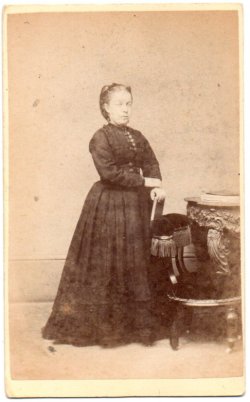 Typical
of the early
1870s, this
lady's day dress
is quite simple
and fairly
plain. The high
neckline of the
buttoned bodice
(the buttons
appear to be the
same colour as
the dress
fabric, while
the four white
'buttons' are,
in fact, a
jewellery
ornament).
Typical
of the early
1870s, this
lady's day dress
is quite simple
and fairly
plain. The high
neckline of the
buttoned bodice
(the buttons
appear to be the
same colour as
the dress
fabric, while
the four white
'buttons' are,
in fact, a
jewellery
ornament).
The skirts are now much reduced and are flatter at the front, with an emphasis at the rear. In the following years the rear 'emphasis' would be enhanced by the use of a bustle.
Of particular
interest is the
chair featured.
This is not a
normal chair,
but a
photographer's
'posing' chair.
This was
designed such
that the 'seat'
could be used
for sitting or
kneeling and the
height of both
the seat and the
padded back
would have been
fully
adjustable, to
accommodate
sitters of
different
heights.
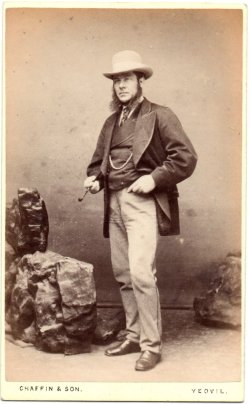 This
photograph by
John Chaffin dates to
1870.
This
photograph by
John Chaffin dates to
1870.
The man, in what is sometimes referred to as a promenade suit, wears a long jacket with very wide lapels and generous sleeves - a refinement of the earlier sack coat.
He wears a collar and silk tie, with a jewelled tie pin through the tie's knot.
His waistcoat, worn with a heavy watch chain, is double breasted and of the same material. It is worn with contrasting light coloured trousers (they are actually finely striped). The ensemble is finished off with a summer hat and a cane.
The scene is somewhat let down by a plain background and incongruous papier-mâché rocks.
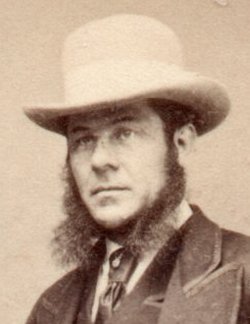 In
Britain the
return of the
beard (the full
beard had last
been in vogue in
Tudor times) was
thanks to the
Crimean War of
1854-56. Beards
had been banned
in the British
army until this
time, but the
freezing
temperatures of
Crimean winters,
and the
impossibility of
getting shaving
soap, led to a
necessary
change. By the
time the last
troops returned
home, beards
were the mark of
a hero. Within a
few years, it
was almost
impossible to
see a beard-free
male face in
Victorian
Britain. During
the 1860s and
'70s, Piccadilly
weepers , or as
the Americans
called them,
Dundreary
whiskers, became
popular. They
were long bushy,
carefully combed
side whiskers,
worn without a
beard.
In
Britain the
return of the
beard (the full
beard had last
been in vogue in
Tudor times) was
thanks to the
Crimean War of
1854-56. Beards
had been banned
in the British
army until this
time, but the
freezing
temperatures of
Crimean winters,
and the
impossibility of
getting shaving
soap, led to a
necessary
change. By the
time the last
troops returned
home, beards
were the mark of
a hero. Within a
few years, it
was almost
impossible to
see a beard-free
male face in
Victorian
Britain. During
the 1860s and
'70s, Piccadilly
weepers , or as
the Americans
called them,
Dundreary
whiskers, became
popular. They
were long bushy,
carefully combed
side whiskers,
worn without a
beard.
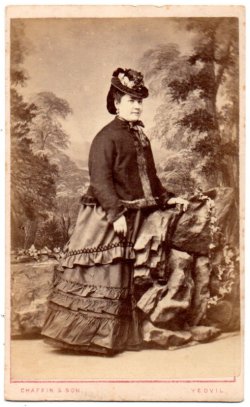 1870's
fashion is
characterised by
a gradual return
to a narrow
silhouette after
the full-skirted
fashions of the
1850s and 1860s.
By 1870,
fullness in the
skirt had moved
to the rear, and
here
elaborately-draped
overskirts were
supported by a
bustle and
secured by
tapes. This
necessitated an
underskirt,
which was
heavily trimmed
with pleats,
ruching, and
frills.
1870's
fashion is
characterised by
a gradual return
to a narrow
silhouette after
the full-skirted
fashions of the
1850s and 1860s.
By 1870,
fullness in the
skirt had moved
to the rear, and
here
elaborately-draped
overskirts were
supported by a
bustle and
secured by
tapes. This
necessitated an
underskirt,
which was
heavily trimmed
with pleats,
ruching, and
frills.
Of special interest is the early use of an elaborately painted 'outdoor' backcloth (the like of which had not been seen for a decade) and the massive 'rock' (probably Papier-mâché) posing aid on a wooden base. It is likely that Chaffin's daughters, who were all artists, painted the backcloth and possibly created the impressive 'rock'.
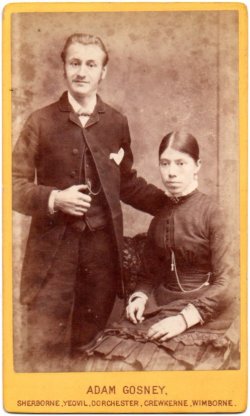 Photographed
in the
late-1870s
by
Adam Gosney
of Sherborne.
Gosney
had a
studio in
Princes Street, as well as Sherborne, Dorchester, Crewkerne and Wimborne.
Gosney also
invested in a
mobile
photographic
studio with
which he
travelled to
many villages
throughout the
district.
Photographed
in the
late-1870s
by
Adam Gosney
of Sherborne.
Gosney
had a
studio in
Princes Street, as well as Sherborne, Dorchester, Crewkerne and Wimborne.
Gosney also
invested in a
mobile
photographic
studio with
which he
travelled to
many villages
throughout the
district.
This lady’s skirts are trimmed with layers of ruching. The sleeves are tight and the cuffs edged with white lace to match that at the high collar. Her hair is severely pulled back.
The man wears a thigh-length cutaway jacket, with tiny lapels, buttoned at
the top, over a
single-breasted
waistcoat.
For the first time we do not see an expanse of carpet below the sitters' feet.
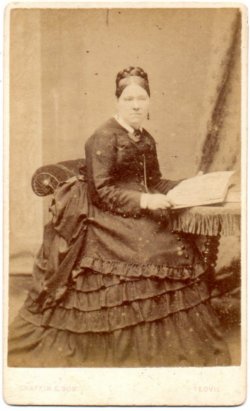 This
carte, also by
Chaffin, dates
to around 1874.
This
carte, also by
Chaffin, dates
to around 1874.
The lady’s bustled dress with its overskirts, is a style that became fashionable around 1873 to 1874 and featured overskirts and an apron-like overskirt, caught up with buckled ribbons. Again, the bustle emphasises the rear of the skirts.
The bodice is of the 'Cuirassier' style with a drop-pointed front, plainly decorated and with quite tight sleeves with button detailing.
Unusually for a photograph at this date, the lady wears large pendulous earrings.
The props are minimal, with the edge of a fringed table supporting a book - the ever-present symbol of education.
Fashions of the 1880s
Ladies' fashion in the middle of the 1880s was characterised by the return of the bustle as emphasis remained on the back of the skirt. The long, lean line of the 1870s was slowly replaced by a full, curvy silhouette with gradually widening shoulders. Fashionable waists were low and tiny below a full, low bust supported by a corset.
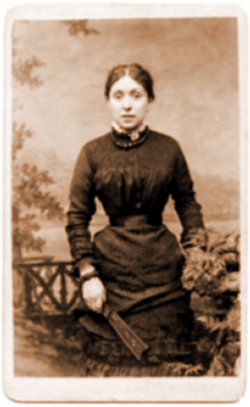 As
in the previous
decade, emphasis
remained on the
back of the
skirt, with
fullness
gradually rising
from behind the
knees to just
below the waist.
The fullness
over the bottom
was balanced by
a fuller, lower
chest, achieved
by rigid
corseting,
creating a
narrow waist and
an S-shaped
silhouette.
As
in the previous
decade, emphasis
remained on the
back of the
skirt, with
fullness
gradually rising
from behind the
knees to just
below the waist.
The fullness
over the bottom
was balanced by
a fuller, lower
chest, achieved
by rigid
corseting,
creating a
narrow waist and
an S-shaped
silhouette.
These gowns typically did not have a long train in the back, which was different from the gowns worn in the 1870s, and were extremely tight. They did still have overskirts. They were known as the "hobble-skirt" due to the tightness of them.
The painted backdrop is 'rustic' and flowers / foliage in the foreground help to give the illusion that the lady is outside, in the countryside.
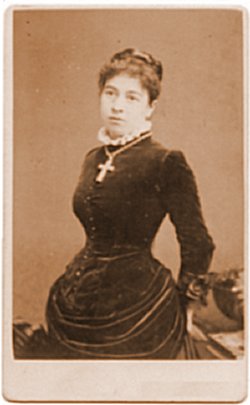 This
lady's velvet
dress emphasises
her tiny
corseted waist
with a draped
overskirt and
bustle. The
effect is
accentuated by
focusing
attention on her
bosom and hips -
producing the
ideal full,
curvy
silhouette.
This
lady's velvet
dress emphasises
her tiny
corseted waist
with a draped
overskirt and
bustle. The
effect is
accentuated by
focusing
attention on her
bosom and hips -
producing the
ideal full,
curvy
silhouette.
Her high collar trimmed with white lace, a carry-over from the previous decade, is typical of the early 1880s.
The background is extremely plain - unusual for this period.
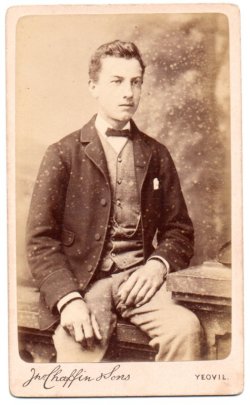 A
good
three-quarters
shot of a young
man seated on a
prop balustrade
in front of a
rural backcloth.
A
good
three-quarters
shot of a young
man seated on a
prop balustrade
in front of a
rural backcloth.
He wears a
tailored jacket,
far less loose
than the earlier
sack coat, with
a high-buttoned,
single breasted
contrasting
waistcoat and
trousers of the
same
finely-striped
material. He
wears a bow tie.
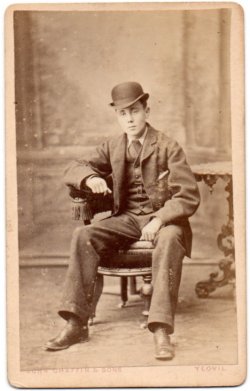 The
man in this
carte wears a
three piece suit
with jacket,
waistcoat and
trousers all in
matching
material (called
a ‘ditto suit’)
and sports a
bowler hat -
traditionally
worn with
informal attire
and favoured by
the working
classes.
The
man in this
carte wears a
three piece suit
with jacket,
waistcoat and
trousers all in
matching
material (called
a ‘ditto suit’)
and sports a
bowler hat -
traditionally
worn with
informal attire
and favoured by
the working
classes.
The man sits on the photographer's adjustable 'posing' chair, and the base of a head support is clearly seen behind the legs of the chair.
The use of props is again sparse.
During the Victorian age, different style clothing was worn according to age and gender. Girls wore mostly skirts and dresses, the style and length changed as they grew older. Meanwhile, the boys wore sailor suits, and clothes that would be considered girls clothes in modern standards.
Girl’s fashion from the Victorian era was mostly based on skirts. At certain ages, the skirts would have to be longer. At first, before they started school, the girls would wear very frilly dresses - the frillier the dress, the richer the family. When they got into school, then they would usually wear skirts. The skirts would start at about knee level, at ten years of age the hemline would drop to about mid-calf, and at sixteen years of age they would go all the way down to their ankles. At this age, the girls started dressing more like adults - even wearing corsets underneath their clothes, to make their bodies look the way that was most popular then.
Boys would also
commonly dress
according to
their age. They
would usually
wear
knickerbockers
as a standard,
casual piece of
clothing. Very
young boys wore
frocks, blouses,
and tunics with
pleated skirts
up until the age
of three or four
(I even have a
photo of my
three-year-old
grandfather in a
dress in 1902).
After this young
age, they wore
knickerbockers
with short,
collarless
jackets. Boys
also wore the
popular
naval-style
uniform, or
'sailor suit',
which consisted
of buttoned
trousers, dark
stockings, black
boots, buttoned
reefer jackets,
and a wide brim
straw hat. Most
of the
naval-style
clothing was
either colored
in white, black,
or navy blue.
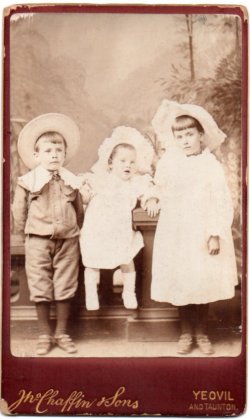 Unlike
in the 1860s
(q.v.), by the
end of the 1880s
children's
clothes were no
longer little
replicas of
their parents'
wardrobes.
Unlike
in the 1860s
(q.v.), by the
end of the 1880s
children's
clothes were no
longer little
replicas of
their parents'
wardrobes.
The children’s
clothes in this
carte are
typical of this
period. The
little girls
wear
loose-fitting
white smock-type
dresses with sun
bonnets. Girls
dresses
continued to be
much shorter
than adults'
hemlines.
The little boy
wears
knickerbockers,
a shirt with a
very large
Oxford collar
and a large sun
hat.
This carte is a
deluxe version
with a
maroon-coloured
stock sporting a
gold edge and
gold lettering.
Note that the front is printed “Yeovil and Taunton” after Chaffin opened his Taunton studio that would eventually be run by his son..
Fashions of the 1890s
Fashionable women's clothing styles shed some of the extravagances of previous decades, so that skirts were neither supported by crinolines as in the early 1860s, nor protrudingly bustled in back as in the late 1860s and mid-1880s, or tight as in the late 1870s. Nevertheless, corseting continued unmitigated, or even slightly increased in severity.
Early 1890's dresses generally consisted of a tight bodice with the skirt gathered at the waist and falling more naturally over the hips and undergarments than in previous years. The 1890s introduced 'leg of mutton' sleeves, which grew in size each year until they disappeared around the end of 1896.
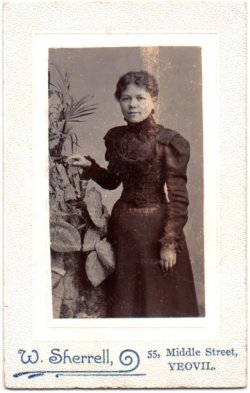 This
is a special
deluxe carte de
visite with the
photograph,
smaller than
normal, set
within an
embossed border.
It is by
William Sherrell.
This
is a special
deluxe carte de
visite with the
photograph,
smaller than
normal, set
within an
embossed border.
It is by
William Sherrell.
The carte dates to the early 1890s, as evidenced by the nascent ‘leg of mutton’ sleeves of the sitter which were tight for most of the length of the arm, but enlarged at the top of the arm.
The dark-coloured day dress is decorated with much lace to the bodice, the sleeve cuffs and the high collar.
Shutter speeds were improving at this time but exposures were still relatively long, so the lady has an ornate pillar, decorated with house plants, with which to steady herself.
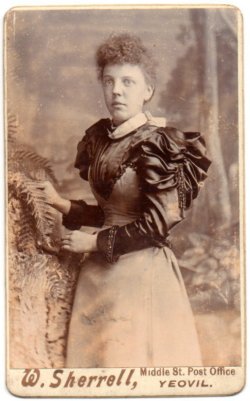 Dating
to around 1895,
this magnificent
dress features
enormous 'leg of
mutton' sleeves
- without doubt
the most extreme
example of this
five-year
fashion in which
sleeves
increased
annually in size
until the
fashion faded in
1896.
Dating
to around 1895,
this magnificent
dress features
enormous 'leg of
mutton' sleeves
- without doubt
the most extreme
example of this
five-year
fashion in which
sleeves
increased
annually in size
until the
fashion faded in
1896.
It is difficult to tell if the bodice and skirt are separate items, but nevertheless the lower half of the bodice is in the same fabric as the skirt. Again, a rigid corset produces a tiny waist while emphasising the bosom.
Again, the lady balances herself on Sherrell's prop column, this time adorned with ferns. There is also a large rural backdrop.
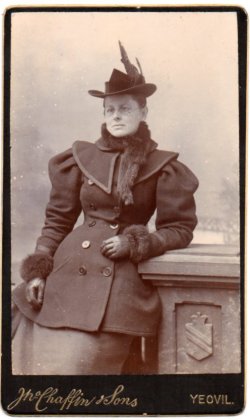
This is a fine deluxe carte de visite, with a plain dark brown back and gold lettering and edging on a heavy cardstock. This is probably one of the last cartes by Chaffin & Sons before they moved to the postcard format.
Dating to around 1895, the lady wears a tailored jacket with exaggerated leg of mutton sleeves, a massive collar and a small dead animal.
Her hair is piled up on top of her head and her hat sits high and straight, trimmed with feathers.
Her skirt appears to be the popular simple A-line of the time.
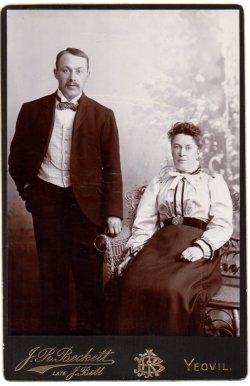 This
photograph, by
Jarrett Beckett,
was produced as
a cabinet card
and dates to
about 1898.
This
photograph, by
Jarrett Beckett,
was produced as
a cabinet card
and dates to
about 1898.
The lady wears a silky, striped blouse with generous, residual ’leg of mutton’ sleeves and is decorated with ribbons and lace at the high collar and cuffs. Her skirt is dark and plain, in contrast to her blouse.
The man wears a three-piece suit with matching coat and trousers but a contrasting, chequered waistcoat. Waistcoats fastened lower on the chest, and were collarless.
His shirt collar is turned over into "wings" - collars were overall very tall and stiffened. He wears a fashionable fancy bow tie.
Fashions of the 1900s
The fashionable silhouette in the early twentieth century was that of the 'confident woman', with full low chest and curvy hips. The 'health corset' of this period removed pressure from the abdomen and created an S-curve silhouette. Early twentieth century blouses and dresses were full in front and puffed into a 'pigeon breast' shape over a narrow waist. Skirts still brushed the floor, even for day dresses, in mid-decade.
For men, the long, lean, and athletic silhouette of the 1890s persisted.
By this time, the carte de visite was little used and the cabinet card was in sharp decline, both being replaced by the new postcard format, enabling photographs - whether they be professionally taken or by enthusiastic amateurs - to be sent to friends and loved ones.
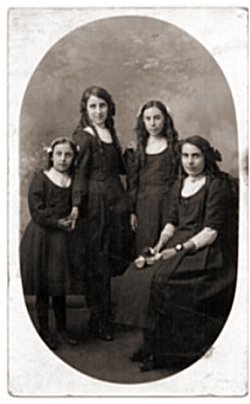 This
is a photograph
of four sisters
produced as a
postcard around
1905.
This
is a photograph
of four sisters
produced as a
postcard around
1905.
The girls all wear similar, but slightly different, dresses. Girls generally wore their dresses shorter than adults and the younger the girl, the shorter the dress.
Note that the eldest (seated) girl wears a wristwatch. Wristwatches were worn only by women before the twentieth century - and more for decoration rather than anything as practical as punctuality.
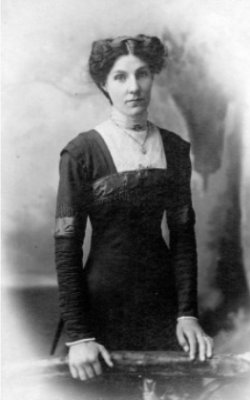 20-year-old
Ellen Warren
photographed in
1909 (and
produced as a
cabinet card,
despite the late
date) in her
wedding dress.
20-year-old
Ellen Warren
photographed in
1909 (and
produced as a
cabinet card,
despite the late
date) in her
wedding dress.
The full-length dress is in a slimming, dark navy, square-cut at the neck but with a white lace, high collar infill. The dress has the smallest of lace cuffs in very tight sleeves, with silk detailing at the elbows matching the detailing across the line of the bosom. The lower sleeves are in a colour-matched crepe.
Her hair style is typical of the Edwardian period.
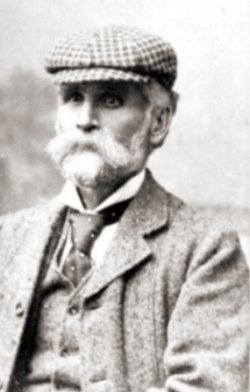 The
Norfolk jacket,
made of sturdy
tweed or similar
materials,
gained
popularity for
rugged outdoor
pursuits, such
as fishing and
shooting.
The
Norfolk jacket,
made of sturdy
tweed or similar
materials,
gained
popularity for
rugged outdoor
pursuits, such
as fishing and
shooting.
It would be worn with matching waistcoat and breeches, when it became the Norfolk suit, suitable for bicycling or golf with knee-length stockings and low shoes.
The man wears a winged collar with a necktie. The flat cap was commonly worn at this time by all classes.
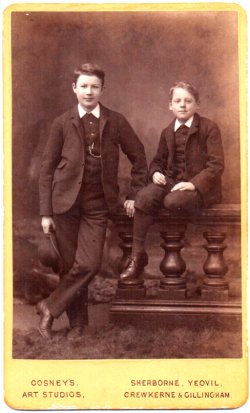 Again
photographed by
Adam Gosney, but
in the carte de
visite format
that had been
abandoned by
most other
photographers.
Again
photographed by
Adam Gosney, but
in the carte de
visite format
that had been
abandoned by
most other
photographers.
These two boys wear suits that would have emulated their father's.
The waistcoats are fastened high on the chest. The usual style, as here, was single-breasted.
The older boy, standing, wears a watch chain and carries a bowler hat while his younger brother wears knickerbocker trousers because of his age.
Fashions of the 1910s
Fashion from 1910–1919 was characterised by a rich and exotic opulence in the first half of the decade in contrast with the sombre practicality of garments worn during the Great War period. Men's trousers were worn cuffed to ankle-length and creased. Skirts rose from floor length to well above the ankle by the end of the decade. Women began to bob their hair, and the stage was set for the radical new fashions associated with the Jazz Age of the 1920s.
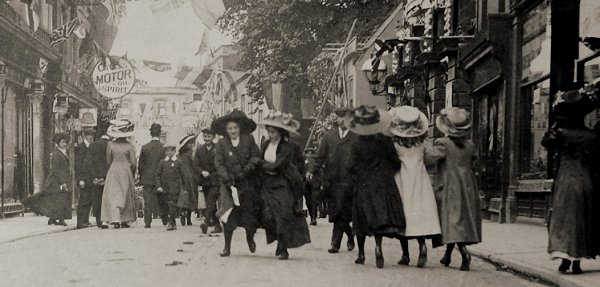
High Street decorated to celebrate the Coronation of George V on 22 June 1911. The ladies at left and right have ankle-length hemlines, but the five younger girls at centre have higher hemlines because of their age. Nearly all the ladies and girls wear fashionable wide-brimmed hats.
 This
photograph dates
to about 1910.
This
photograph dates
to about 1910.
Large hats with wide brims and broad hats with face-shadowing brims were the height of fashion in the early years of the decade, gradually shrinking to smaller hats with flat brims.
Fur muffs and stoles were important fashion accessories in this period.
Beneath her coat this young lady wears a separate blouse and skirt; the blouse has a high frilly collar while the skirt length is just a couple of inches clear of the ground.
 This
studio portrait
is by
Grace Cumming,
who was only
active as a
photographer in
Yeovil in 1911
and 1912. Grace
died in 1913.
This
studio portrait
is by
Grace Cumming,
who was only
active as a
photographer in
Yeovil in 1911
and 1912. Grace
died in 1913.
Produced as a postcard, it is embossed with Grace's name at the bottom right corner.
By this time the man’s double-breasted jacket has morphed from the earlier sack coat to become the modern suit jacket. He wears matching trousers and probably wears a matching waistcoat.
The background is a simple swag of material.
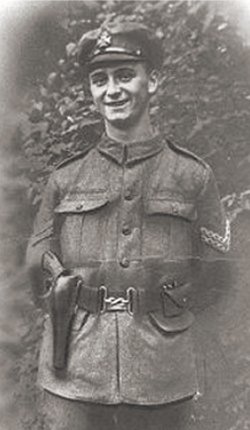 During
the 1914-1918
War, the vast
majority of
men’s clothing
naturally tended
to be military
in nature.
During
the 1914-1918
War, the vast
majority of
men’s clothing
naturally tended
to be military
in nature.
This corporal had his photograph taken while on leave.
It was usual for servicemen to have a photographic portrait as a keepsake for their loved ones while they were away on active service. These are more numerous today than any other type of portrait of this decade.
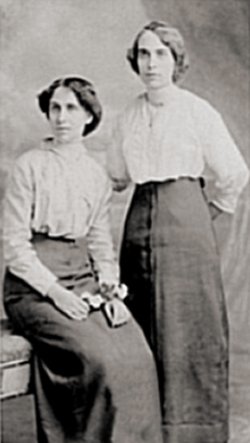 This
photograph of
two sisters
dates to about
1917 and shows
the very plain
style that
became popular
during the Great
War.
This
photograph of
two sisters
dates to about
1917 and shows
the very plain
style that
became popular
during the Great
War.
Both ladies wear simple long-sleeved blouses with high necks with ankle-length plain skirts.
These are the two elder sisters shown in the photograph of the four sisters of 1905 above.
Fashions of the 1920s
The 1920s was the decade in which fashion entered the modern era. It was the decade in which women first abandoned the more restricting fashions of past years (the confining corset was discarded by most) and began to wear more comfortable clothes.
The decade was characterised by two distinct periods of fashion. In the early part of the decade, change was slow, as many were reluctant to adopt new styles. From 1925, the public passionately embraced the styles associated with the Roaring Twenties.
Men also generally abandoned highly formal daily attire and even began to wear athletic clothing for the first time. The suits men wear today are still based, for the most part, on those worn in the late 1920s.
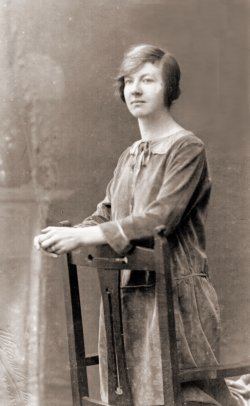 Photographed
by
Witcomb & Son
around 1924, and
produced as a
postcard.
Photographed
by
Witcomb & Son
around 1924, and
produced as a
postcard.
This lady, with her bobbed hair, wears a drop-waisted dress with a loose, straight fit and shorter sleeves.
Although unseen in this photograph, the length of her dress would be just below the knees.
Further, she is unencumbered by the rigid corsetry of previous decades.
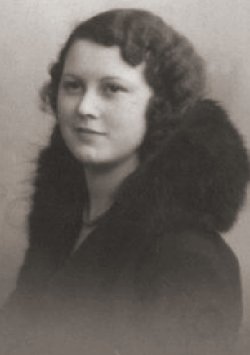 By
1920 the
'bobbed' hair
style was
rapidly becoming
fashionable
although in the
early 1920s it
was still seen
as a somewhat
shocking
statement of
independence in
young women, as
older people
were used to
seeing girls
wearing long
dresses and
heavy
Edwardian-style
hair.
Hairdressers,
whose training
was mainly in
arranging and
curling long
hair, were slow
to realise that
short styles for
women had
arrived to stay.
The bobbed style
became standard
by the end of
the decade.
By
1920 the
'bobbed' hair
style was
rapidly becoming
fashionable
although in the
early 1920s it
was still seen
as a somewhat
shocking
statement of
independence in
young women, as
older people
were used to
seeing girls
wearing long
dresses and
heavy
Edwardian-style
hair.
Hairdressers,
whose training
was mainly in
arranging and
curling long
hair, were slow
to realise that
short styles for
women had
arrived to stay.
The bobbed style
became standard
by the end of
the decade.
This young lady wears the most iconic 1920s coat, the fur collar wrap coat, or 'cocoon coat'. This was a woman’s prized possession. Almost every woman owned one and wore it throughout the year.
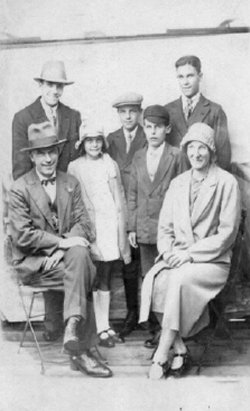 This
formal family
group photograph
dates to 1928
and shows a
range of 'Sunday
best' clothing.
This
formal family
group photograph
dates to 1928
and shows a
range of 'Sunday
best' clothing.
For the first time in centuries, women's legs were seen with hemlines rising almost to the knee and dresses becoming more fitted.
The cloche hat was a fitted, bell-shaped hat for women that was invented in 1908 but became especially popular from about 1922 to 1933.
Although the younger lads wear a standard 'newsboy' cap and a flat cap, these were also popular with working class men at this time - as were the trilby hats worn here by the older men.
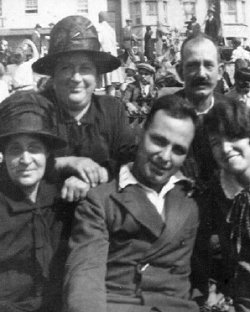 The
ever popular
'box brownie'
camera (invented
in 1900) allowed
people to take
their own
photographs at
any location as,
for example,
this scene on a
crowded beach.
The
ever popular
'box brownie'
camera (invented
in 1900) allowed
people to take
their own
photographs at
any location as,
for example,
this scene on a
crowded beach.
While the older ladies at left retain their somewhat old-fashioned clothes and hats, the young couple have a far more relaxed wardrobe - an open shirt collar (albeit still with a double-breasted suit jacket buttoned up, even on the beach).
Even the older man has removed his stiff shirt collar for the occasion.